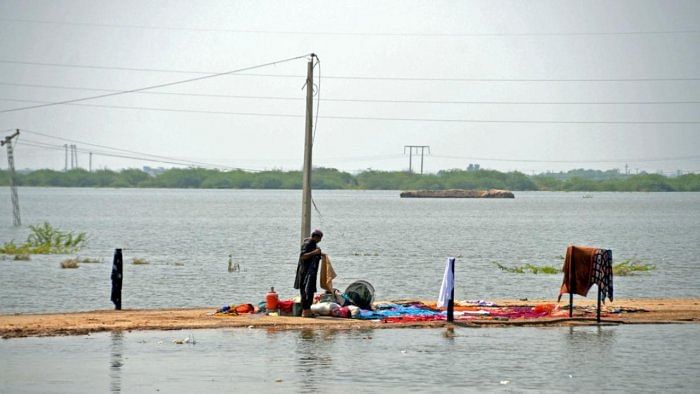
The flood relief activities in Pakistan are likely to continue for the next two years, planning minister Ahsan Iqbal said on Thursday, citing the devastating effects of the cataclysmic floods that have left 1,666 persons dead since mid-June.
The floods have left a third of the country submerged under water and caused estimated damage of nearly $30 billion, Geo News reported.
Iqbal, Minister for Planning, Development, and Special Initiatives blamed climate change for the unprecedented rainfall and flooding that have injured hundreds of thousands of persons and displaced more than 33 million others.
"Natural disasters are a result of climate change, however, we are coming up with plans to deal with them in the future. For now, the government has allocated Rs 40 billion for 20 underdeveloped districts," he said.
Apart from the lives lost, more than two million houses have been destroyed and over one million livestock — a major source of income for rural households — have been lost in the floods.
The floods have also raised questions on whether the cash-strapped country would be able to pay its debts on time, with the local currency weakening against the dollar and the forex reserves dwindling.
Prime Minister Shehbaz Sharif and Foreign Minister Bilawal Bhutto-Zardari have sought climate justice to compensate for the destruction as the disaster was climate-induced and Pakistan, which emits one of the lowest carbon in the world, is bearing the brunt of the emission caused by the developed countries.
Meanwhile, hundreds of thousands of people displaced by the floods and living in the open camps have expressed dissatisfaction with the government for its failure to provide relief and support.
According to the National Disaster Management Authority (NDMA), Sindh ranks first among the worst-affected provinces due to what the World Health Organisation (WHO) has termed the “monster monsoon”.
Shabira Khatoon, 35, who sits quietly amid the chaos, does not bat an eyelid as she is still not able to recover from the shock of losing her newborn child.
Samina, her 13-year-old daughter, said most of the children living in the camps had "high fevers and been diagnosed with either dengue or malaria".
"Nearly 80 per cent of children here are sick with malaria and diarrhea.”
The WHO has said the surge in diseases like malaria, dengue fever, skin and eye infections, and acute diarrhea had the potential for a “second disaster”.
“The night before we came to Karachi, my mother was in labour,” said teenager Samina, suddenly looking much older than her age.
“It was pouring down heavily and we had rushed to the Larkana Civil Hospital in a hurry. But for 10 hours that day, my mother was lying in the operation theatre […] waiting for a doctor without any electricity. We waited until 3 am […] the next morning my mother gave birth to a still baby girl,” she said.
“For nearly 1,000 people, we just have four washrooms, of which two are toilets and in dire condition,” Faqeer Ghaus Bakhsh from Sindh’s Meharpur area said.
A girl standing in the crowd of people gathered nearby said: “Ye humara watan thori hay (this is not our country)."
“This is not our country. We have been locked up in a room here and aren’t allowed to leave or go anywhere,” the girl TOLD Dawn newspaper.
Another flood victim said the government was now planning on moving all the affected people to a relief camp — a tent city — in Surjani town.
“Jungle main le ja k phenk den gain ye log humain (they will throw us in the jungle) […] they say we will be provided with all the facilities there,” Qurban Ali from Mehar said.
Sakina Ali from Mehrabpur district, who lived at the camp with her grandchildren, said: “It is all a scam […] the government […] They promised to give us Rs 25,000 under the Benazir Income Support Programme but it is all a fraud.”
Under its Flood Relief Cash Assistance Programme, the government had earlier announced to give Rs 25,000 via the Benazir Income Support Programme to the flood-affected persons.
The woman in her mid-50s explained that she had visited the Nadra office first thing after arriving in the city.
“They said I can withdraw the money from the bank but when I went there, the money just won’t come out of the machine [ATM],” she explained.